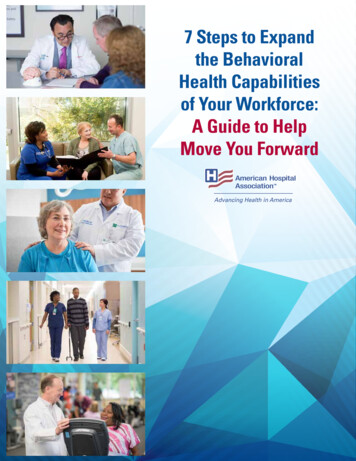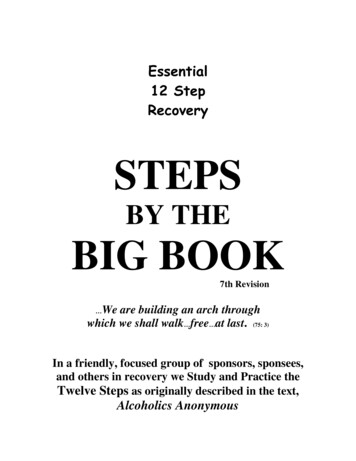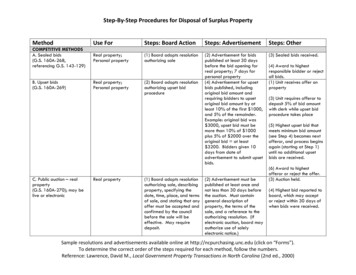
Transcription
7 Steps to Expandthe BehavioralHealth Capabilitiesof Your Workforce:A Guide to HelpMove You Forward
7 Steps to Expand the Behavioral Health Capabilitiesof Your Workforce: A Guide to Help Move You ForwardIntroductionIn spring 2016, the AHA published a white paper, “The State of the Behavioral Health Workforce: ALiterature Review.” The conclusion included seven steps that describe how a hospital or health systemcan strengthen its behavioral health workforce.This guide builds on those concepts to include how to expand the capabilities of your workforce aroundaddressing behavioral health needs. It offers new perspectives as well as tips and suggestions that canhelp you move your organization forward more rapidly, efficiently and effectively.Step 1: Assess your current workforce knowledge and skills as well as your patient population.Step 2: Ensure your workforce is knowledgeable about the socioeconomic determinants of healthand the challenges facing your community, and make sure they are culturally competent.Step 3: Educate your entire workforce to identify the signs and symptoms of behavioral healthdisorders and know where and how to refer for screening.Step 4: Set up a procedure of assessment, treatment and referral so that behavioral health care ishappening at the site of visit, if possible.Step 5: Use interprofessional education and training and team-based care for your current andfuture workforce to begin integrating primary and behavioral health care.Step 6: Contact higher education programs in your area to establish partnerships that address theneeds of the population your hospital or health system serves, as well as enhance the recruitmentand retention of behavioral health professionals.Step 7: In order to strengthen care transitions and integration, engage the broader community,including: Community groups Community health centers Mental health care and substance abusetreatment providers Social service agencies Local law enforcementJudicial systemsSchoolsChurches and religious organizations1
Step 1Assess your current workforce knowledge and skills as well as your patient population.Challenge: There are many different workforce assessments available. How do you choose the best one?Solution: Look to hospitals that have conducted similar assessments and replicate their methods.Implementation Ideas:1. Refer to these assessment tools developed by the AHA to begin this process: “ACHI Community HealthAssessment Toolkit” and “Developing an Effective Health Care Workforce Planning Model.”2. Choose organizations that are similar to yours in size and demographics. In most cases, it is not necessary tobuild an assessment from scratch. Locate and ask peer hospital groups what assessment tools have worked wellfor them and if you can review their assessment resources. Your state or metropolitan hospital association may beable to help you identify similar organizations.3. Draw from your existing data. As much as possible, repurpose existing patient and workforce data to populateyour assessment.Step 2Ensure your workforce is knowledgeable about the socioeconomic determinants of health and the challenges facing yourcommunity, and make sure they are culturally competent.Challenge: Chances are your workforce has undergone some general training on these topics. However, they likely havehad little training to help them understand how these factors impact behavioral health and their roles. Where should youbegin?Solution: Educate your workforce on the results of your community health needs assessment and other assessmentsto provide a broad, yet timely, snapshot of your community’s challenges. Contact behavioral health providers in yourarea from diverse backgrounds or who work with diverse ethnic and economic populations. Ask them to share theirperspectives so your workforce has the most recent information and can build new skills and understandings.Implementation Ideas:1. Assemble an interprofessional panel or advisory group. Invite these providers to participate in a panel discussion(either in-person or virtual) on current issues related to cultural and socioeconomic factors as they impactbehavioral health. Invite your workforce and include a Q-and-A session at the end. Challenge your workforce toprovide examples of how they can adapt their actions/processes to better address the cultural and socioeconomicneeds of the patients they serve. Consider making this a quarterly or annual event, and provide feedback to theworkforce on improvement or best practices.2. Include issues related to seniors as part of your discussion. Seniors – whether they are from a majority or minoritypopulation, or whether they are economically challenged or well off – face unique challenges related to behavioralhealth. With the senior population of the U.S. growing rapidly, it is critical that your workforce have a clearunderstanding of seniors and their unique behavioral health issues. Working with the local Alzheimer’s associationor a local aging council could enhance your work and expand your organization’s access to resources in this area.3. Consider a Community Medicine Rotation. Through this experience, residents learn about and experience socialservice resources, which will allow them to better assist patients with complex behavioral health issues. Theyalso can become culturally competent, compassionate providers. To learn more about a successful communitymedicine rotation program, go to Florida International University’s Green Family Foundation Neighborhood HELPprogram.2
4. Engage a patient advisory group from the community you serve. Invite this group to provide feedback and insightson how your organization can be more respectful of, and supportive of, the needs of the diverse members of yourcommunity. Consider incorporating their feedback into the strategic planning process and/or the onboarding/training of your workforce.Step 3Educate your entire workforce to identify the signs and symptoms of behavioral health disorders and know where and howto refer for screening.Challenge: Your workforce is large and time and resources to conduct training are limited. How can you accomplish this?Solution: Provide “on-demand” training so employees can access it when they have time.Implementation Ideas:1. Keep the training as generic as possible. Ensure no patient data or sensitive information is included in the training– this way staff can access training off-site or from their homes, in addition to at work.2. Be sure to offer a platform where your workforce can ask questions. Consider hosting and recording a webinar,publishing a simple blog or FAQs, or provide a contact person and an email address for employees to sendworkforce-related questions to regarding behavioral health. Appointing a go-to staff person or content expertliaison on behavioral health care would be beneficial to talk through any complex issues. Engage your employeeassistance program in this platform.3. Consider using the following assessments and screening tools as a guide: Screening, Brief Intervention, Referral to Treatment(SBIRT) Training (to improve clinical skills insubstance use screening and referral) The Trauma Informed Care Project Primary Care PTSD Screen (PC-PTSD) Cut Down, Annoyed, Guilty Eye Opener (CAGE)Questionnaire (for Alcohol) Patient Health Questionnaire (PHQ-9) (forDepression) Hurt-Insult-Threaten-Scream (HITS) (for DomesticViolence) UNCOPE (for Substance Use) Columbia- Suicide Severity Rating Scale (C-SSRS)Step 4Set up a procedure of assessment, treatment and referral so that behavioral health care is happening at the site of visit, ifpossible.Challenge: Providers are already challenged to deliver quality care in a limited timeframe. How will they have time to addin behavioral health assessments as well?Solution: Work to integrate physical and behavioral health services at the provider level by embedding behavioral healthclinicians (real or virtual) who work with the physical health providers to treat the patient. Develop knowledge of the fullcontinuum of services and providers that are available in your community to improve the timeliness of referral (if needed)and treatment.Implementation Ideas:1. Consider both the patient assessment and delivery process. Understand how behavioral health care is currentlybeing delivered in your organization as well as how care will be delivered in your community in the future. Afteryou have chosen which assessment to use, determine how it will best integrate into your already-established3
processes. Use the Substance Abuse and Mental Health Services Administration’s Integrating Primary Care andBehavioral Health Care assessments and Agency for Healthcare Research and Quality’s Academy for IntegratingBehavioral Health and Primary Care’s Integration Playbook as starting points.2. Consider carefully what will happen when the patient leaves your location. The process is complete and valuableonly when all the steps are clearly outlined. That means not only identifying that a patient requires assistance, butspecifically how that patient will navigate from this point of care to the services he or she needs. Consider creatingyour own patient navigator roles to fill this gap if a patient’s support system outside the hospital is limited or nonexistent.3. Convene or participate in conferences that disseminate information on this method of care delivery. Promotionand buy-in for transforming behavioral health delivery must begin with senior leaders. Demonstrating that this isa priority for your organization will give your initiative more credibility – both internally and externally. Considerstarting an anti-stigma campaign in your own organization, and be aware that the social stigma of seeking andreceiving behavioral health care can differ based on the racial, socioeconomic and religious make-up of yourcommunity. In addition, building behavioral health screenings into your diabetes/cardiac community screeningprograms ensures reaching additional community members and provides an opportunity to erase stigma.Step 5Use interprofessional education and training and team-based care for your current and future workforce to beginintegrating primary and behavioral health care.Challenge: Provider and organizational capacity for the change in care delivery, training and support is limited.Solution: Convene a group of providers from the community to discuss and strategize successes, challenges andinnovative ideas on how to provide high-quality, efficient care in an interprofessional setting.Implementation Ideas:1. Consider implementing TeamSTEPPS or a similar training program for interprofessional, team-based care acrossthe organization, particularly between primary and behavioral health providers.2. Based on a community health needs assessment, and, if necessary, a survey of providers and clinicians,benchmark how behavioral health care is being delivered and will be delivered in the future. This also is achance to uncover perceived barriers to integration, opportunities to enhance team-based care and organizationalstrengths that can be built on to implement an efficient, interprofessional setting.3. Strengthen the knowledge of local providers with evidence-based behavioral health practices. The IMPACTmodel for depression care from the University of Washington, Seattle, Wash., is a great evidence-based tool toimplement collaborative, diverse care for a variety of behavioral health conditions.Step 6Contact higher education programs in your area to establish partnerships that address the needs of the population yourhospital or health system serves, as well as enhance the recruitment and retention of behavioral health professionals.Challenge: Looming retirements of the aging health care workforce threatens to increase professional shortage areas.Simultaneously, a multigenerational workforce provides a challenging landscape to develop the workforce that best meetsyour community’s needs. Your organization should work to develop programs that help foster a cohesive, multigenerationalworkforce, and attract millennials, the demographic most likely to fill roles in your organization in the future. How can youattract and retain them?Solution: Learn some important facts about millennials, their desires and their mindsets before developing new4
partnerships or programs. Review these recent statistics: Millennials listed “a high-paying job” as the least important characteristic for a jobSource: Pew Research Center 72% of current millennial students said they want a job with a greater purpose 71% of millennials wanted to consider their co-workers as their “second family”Source: Forbes, “Why Millennials Are Ending The 9 To 5,” August 13, 2013. 75% of millennials said that work-life balance was the key thing they looked for when planning their careersSource: U.S. Chamber of Commerce Foundation, The Millennial Generation Research Review, 2012Training the incumbent workforce on identifying and treating patients with behavioral health conditions is equallyimportant. Cross training and utilizing an interprofessional behavioral health treatment team can help create the bestworkforce to meet the needs of patients and the community.Implementation Ideas:1. Recognize that for many millennials a “job with a greater purpose” will lead them to health care. Capitalize onthis by developing resources that specifically discuss behavioral health careers, the workforce needs in this areaand how their contribution can make a difference.2. Take advantage of the knowledge higher education staff have to offer, and learn from their past successes withmillennials. Meet with higher education representatives to learn what programs have worked well for them anddiscuss ways to incorporate similar tactics into your offerings.3. Examine your local higher education and training infrastructure. Addressing barriers, such as a lack of clinicalsites, faculty shortages or inadequate community resources, by promoting partnerships with higher educationinstitutions may be helpful in promoting educational transformation that improves delivery of behavioral healthcare in the community.4. Increase recruitment of those with local backgrounds and community connections. Engage medical schools,residency programs and other behavioral health professions programs in your area regarding selection of localstudents and residents who might be more likely to remain in the area as behavioral health providers.5. Work with your human resources department to enhance recruitment packages to appeal to millennials or thosewho are pursuing behavioral health care as a second career. Consider implementing loan forgiveness and/orreimbursement programs for master’s level education/additional certification if these credentials are job-related.Implement flexible work hours whenever possible and offer telecommuting options when you can, as millennialshighly value them.6. Provide timely updates and training on new technology to foster a culture of innovation. Consider offeringeducational sessions where all ages are represented and learn to work with and from each other.Step 7In order to strengthen care transitions and integration, engage the broader community, including: Community groups Community health centers Mental health care and substance abuse treatment providers Social service agencies Local law enforcement Judicial systems Schools5
Churches and religious organizationsChallenge: These outside groups have limited time and resources, and can be hard to engage. How can you gain theirattention?Solution: Become a convener and invite community stakeholders to your institution to share goals and to establishcollaborative relationships.Implementation Ideas:1. Make your purpose clear. Before you connect with outside groups, consider giving your outreach initiative amission and a name. Ensure your messages focus on what you both can gain through collaboration – and makesure all understand that this is an equal opportunity initiative, no one organization can do it by themselves.2. Don’t just conclude your meetings or collaborations: Be sure you come away with data you can use. Onesuggestion is to create informal surveys for community groups that can allow you to generate quality data quickly.Build time into your webinars or meetings for attendees to take these surveys before they leave the session.For additional resources and information, go to: www.aha.org/workforce and www.aha.org/behavioralhealth.Chicago Office155 N. Wacker Dr.Chicago, IL 60606312.422.3000Washington, D.C. Office800 10th Street, NWTwo CityCenter, Suite 400Washington, DC 20001202.638.1100www.aha.org 2016 American Hospital Association5
7 Steps to Expand the Behavioral Health Capabilities of Your Workforce: A Guide to Help Move You Forward Introduction In spring 2016, the AHA published a white paper, “The State of the Behavioral Health Workforce: A Literature Review.” The conclusion included










